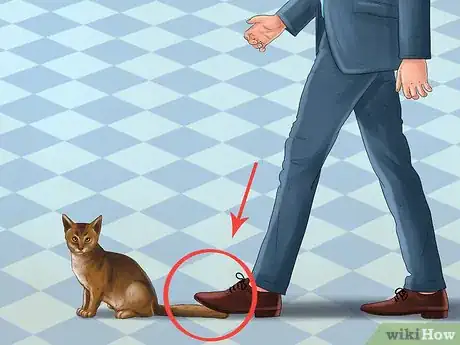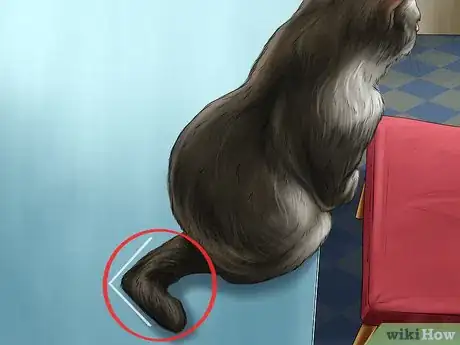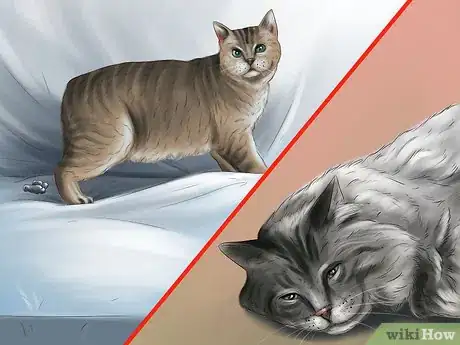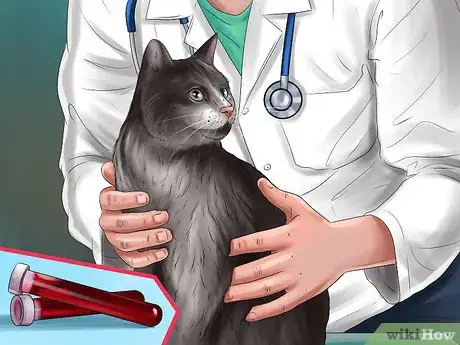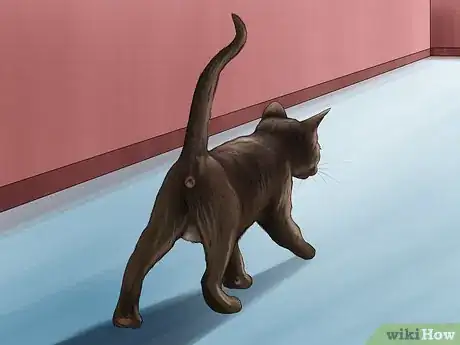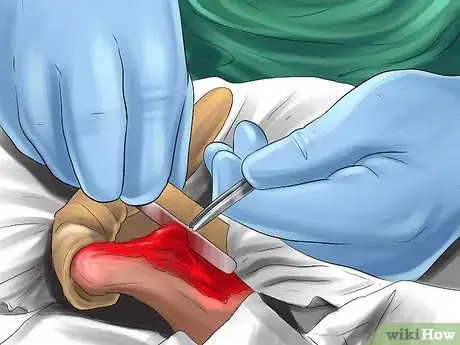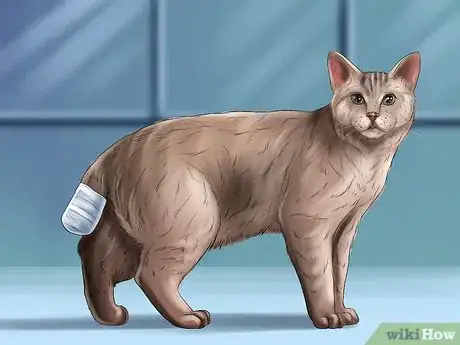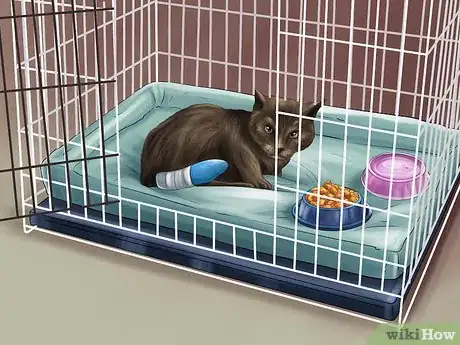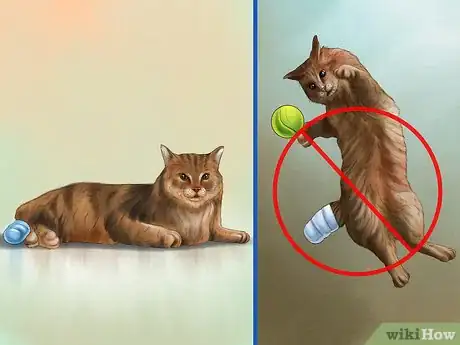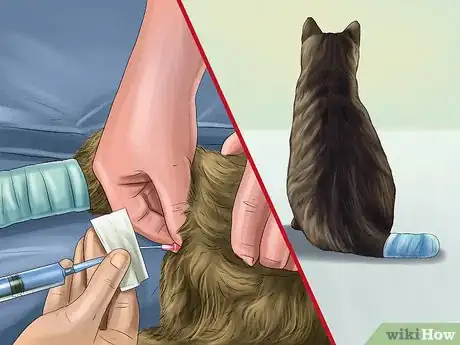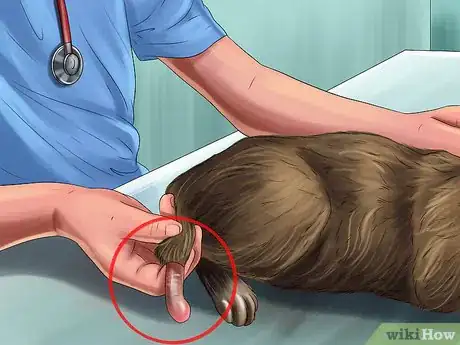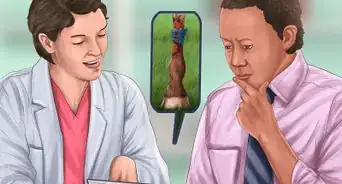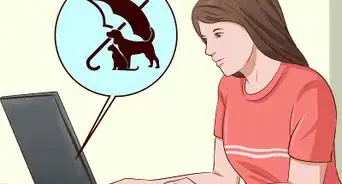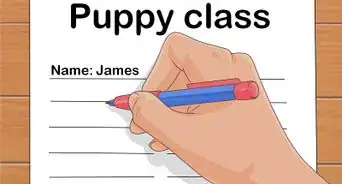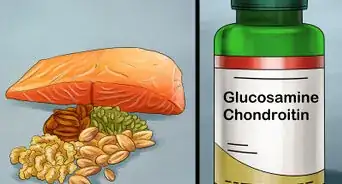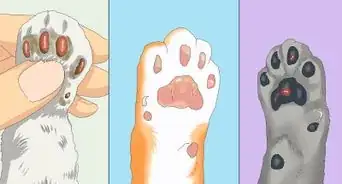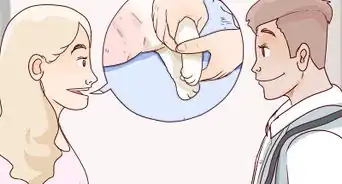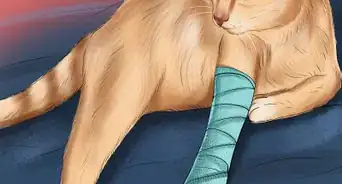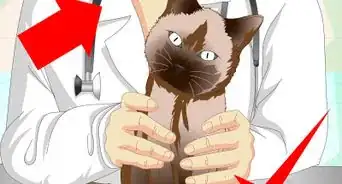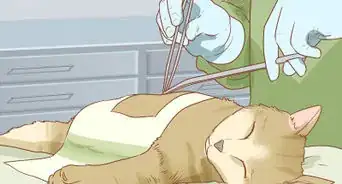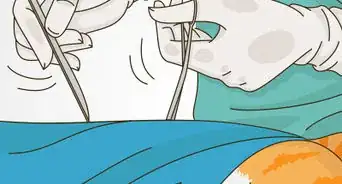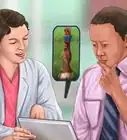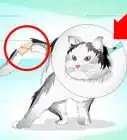This article was co-authored by Pippa Elliott, MRCVS. Dr. Elliott, BVMS, MRCVS is a veterinarian with over 30 years of experience in veterinary surgery and companion animal practice. She graduated from the University of Glasgow in 1987 with a degree in veterinary medicine and surgery. She has worked at the same animal clinic in her hometown for over 20 years.
There are 9 references cited in this article, which can be found at the bottom of the page.
This article has been viewed 49,323 times.
Your cat’s tail is a prominent extension of its spine. The tail helps the cat judge distances and achieve its amazing sense of balance.[1] There are different ways your cat may get a tail pull injury such as by someone accidentally stepping on it. Cat tail pull injuries are extremely painful and can lead to problems such as incontinence. By identifying a potential problem and getting prompt veterinary care, you can potentially treat a cat tail pull injury.
Steps
Identifying a Tail Pull Injury
-
1Recognize common causes of tail pull injuries. There are many different ways a cat might get a tail pull injury. These include the tail being:[2]
- Slammed by a door.
- Stepped on or pulled by a person.
- Bitten off by another animal.
- Run over by an automobile or other moving vehicle.
-
2Observe physical symptoms. Many cat owners may quickly notice when their cat has a tail pull injury through visual means alone. Looking for the different physical signs of a pull injury can help you get prompt treatment for your cat. Signs of a pull injury may include:[3]
- A limp tail.
- A bend or kink in the tail.[4]
- A paralyzed tail.
Advertisement -
3Watch your cat’s behavior. Some cats may not exhibit any physical symptoms of a tail pull injury. In these cases, there are behavioral symptoms that can indicate a tail pull injury. The most common behavioral symptom is urinary or fecal incontinence, since the tail helps control bladder and bowel function.[5] Additional behavioral signs of a tail pull injury may include:
Getting Prompt Veterinary Care
-
1Contact your cat’s vet. If you notice or suspect a tail pull injury in your cat, it’s important to get prompt medical attention. Although many tail pull injuries will heal on their own, a vet can provide a definitive diagnosis and provide the best treatment plan for your cat.[8]
- Call the vet’s office or an emergency vet clinic to inform them that your cat has or may have a tail pull injury. Provide any relevant details such as if your cat is howling in pain and not able to control its urinary function. This can ensure you get a diagnosis and treatment as soon as possible.
-
2Undergo an examination. A cat’s tail is important to many bodily functions, including continence and balance. Because of this, your cat’s vet will do an extensive exam. The exam may include touching different parts of your cat’s body and getting diagnostic tests including X-rays and bloodwork.[9]
- Tell your vet any specific symptoms you have noticed in your cat. This can help the doctor better assess the injury. Answer any questions that your vet may have about your cat’s behavior or physical signs of injury.
- Allow your vet to perform a complete physical and neurological examination on your cat. This can detect potential related conditions including spinal displacement.[10]
- Recognize that your vet may perform blood work, a urinalysis, or X-rays on your cat. These can also rule out other conditions that may appear like a pull injury.
-
3Let the injury heal by itself. In most cases, a tail pull injury can heal on its own. Most vets will see if the tail pull injury mends on its own before trying more invasive treatments such as surgery or amputation.[11]
- Make sure your cat gets sufficient rest, which can promote healing.
-
4Fix broken tail bones with surgery. If your cat’s tail is broken, dislocated or isn’t healing well naturally, your doctor may suggest surgery. A surgical procedure to reset any tail bones or vertebrae can help your cat heal more effectively as well as restore feeling and continence.[12]
- Allow your cat plenty of rest following its surgery. This can promote healing and minimize the risk of infection.
- Follow your vet’s post-op instructions. This will likely include rest, pain medication and a course of antibiotics. Your vet may also prescribe medications stool softeners for constipation or bladder expressing if your cat has no sensation in its urethra.
-
5Have the tail amputated. Your cat’s tail may be severely broken or there may be related spinal or pelvic damage. This may cause permanent loss of sensory and motor functions.[13] If this is the case, your vet will likely suggest amputating your cat’s tail to prevent further injury to the cat’s nerves. Amputation won’t disable your cat in any way.[14]
- Be aware that tail amputation due to injury is common for cats.[15] It can take your cat—and you—time to get used to not having a tail, but it is unlikely that the amputation will have a long-term impact on your cat’s behavior.[16]
- Follow your vet’s post-op instructions. Even though it is common, amputation is still major surgery. The instructions may include giving your cat pain meds, antibiotics, stool softeners, and how to operate a urinary catheter.
- Contact your vet immediately if you notice any signs of infection at the amputation site. These may include: bleeding or leakage from the site, swelling, bruising, pale gums, strong body odor, diarrhea, difficulty breathing.[17]
Managing the Injury at Home
-
1Create a cozy environment. It may take up to a month for your cat’s tail to heal. Your cat may have low energy and/ or little appetite following a tail pull injury or surgery. Rest is one of the most important components of your cat’s recovery. You can help your cat rest and recuperate at home by putting its food and water dishes, bedding, and litter box in a quiet place.[18]
- Consider making a cozy space in a separate room or crate for your cat. This can help you better observe your cat and its recovery.
- Place warm blankets in your cat’s space. These can invite your cat to rest often.
- Make sure to provide fresh food and water at least once every day, even if your cat doesn’t have much of an appetite. This can minimize the risk of infection.
- Understand that cats are very clean and sensitive to their litter box. Provide your cat a clean little box filled with shredded paper instead of litter. This can minimize the risk of infection from litter dust.[19]
-
2Limit your cat’s activity. Your cat may have very few symptoms following treatment for a tail pull injury. If this is the case, it’s still important that you cat rest for at least a week. Limiting activities such as running, jumping, and playing with you or other pets can help your cat heal and minimize the risk of further injury.[20]
- Let your cat get mild exercise such as playing with a ball in its rest area or crate.
- Keep your cat indoors if it goes outside. This can also help prevent further injury, infection, and even attacks by other animals.
-
3Aid your cat’s incontinence. Many cats experience urinary and fecal incontinence because due to a lack of sensation from a tail pull injury. This may continue during treatment, but about 60% of cats recover their continence. If your cat has any type of incontinence, provide as much support during this time as possible. In some cases, cats may never regain continence, which may require manual expression or catheterization.
- Recognize that your cat’s vet will let you know the best way to handle the cat’s incontinence. Your cat may require manual expression of the bladder by your vet or you at home. The vet may also suggest a cystotomy, or surgical incision, into your cat’s bladder to aid urinary incontinence.[21]
- Give your cat stool softeners as advised by your doctor to aid any constipation.
- Let your vet know if the incontinence gets worse or doesn’t go away. The vet can suggest different or alternative treatments for it.
-
4Attend follow-up vet visits. Your cat will likely need to visit its vet on multiple occasions following a tail pull injury or surgery. These appointments determine if healing properly and is in relatively good health. Avoid missing any appointments to ensure your cat’s tail and overall health.
- Schedule follow-up visits as often as your vets suggest or is necessary if your cat is experiencing additional problems with its tail.
References
- ↑ https://www.vetinfo.com/cat-tail-injuries.html
- ↑ https://www.vetinfo.com/cat-tail-injuries.html
- ↑ http://www.petplace.com/article/cats/diseases-conditions-of-cats/emergency-trauma-urgent-care/tail-trauma-in-cats
- ↑ https://www.vetinfo.com/cat-tail-injuries.html
- ↑ http://www.petplace.com/article/cats/diseases-conditions-of-cats/emergency-trauma-urgent-care/tail-trauma-in-cats
- ↑ http://vanat.cvm.umn.edu/NeuroLectPDFs/LectSpReflexNeuronInteg.pdf
- ↑ https://www.cliniciansbrief.com/article/managing-tail-pull-injuries
- ↑ http://www.petplace.com/article/cats/diseases-conditions-of-cats/emergency-trauma-urgent-care/tail-trauma-in-cats
- ↑ https://www.cliniciansbrief.com/article/managing-tail-pull-injuries
- ↑ http://www.petplace.com/article/cats/diseases-conditions-of-cats/emergency-trauma-urgent-care/tail-trauma-in-cats
- ↑ https://www.vetinfo.com/cat-tail-injuries.html
- ↑ http://www.petplace.com/article/cats/diseases-conditions-of-cats/emergency-trauma-urgent-care/tail-trauma-in-cats
- ↑ https://www.cliniciansbrief.com/article/managing-tail-pull-injuries
- ↑ http://www.petplace.com/article/cats/diseases-conditions-of-cats/emergency-trauma-urgent-care/tail-trauma-in-cats
- ↑ http://www.cat-world.com.au/Cat-Health-Collection/tail-amputation-in-cats.html
- ↑ https://www.purina.co.uk/cats/health-and-nutrition/cats-with-special-needs/amputation-in-cats
- ↑ https://www.petcarerx.com/article/caring-for-your-cat-after-surgery/831
- ↑ http://www.petplace.com/article/cats/diseases-conditions-of-cats/emergency-trauma-urgent-care/tail-trauma-in-cats
- ↑ https://www.petcarerx.com/article/caring-for-your-cat-after-surgery/831
- ↑ https://www.petcarerx.com/article/caring-for-your-cat-after-surgery/831
- ↑ http://www.ncbi.nlm.nih.gov/pmc/articles/PMC3280787/
About This Article
If you think your cat might have a tail pull injury, it’s important to take it to the vet for treatment as soon as possible. The vet will do a physical exam of your cat, and may also X-ray it or perform blood tests. In most cases, the vet will recommend that you allow the injury to heal on its own. If that’s the case, try to limit the cat’s activity as it recovers, and help it stay as comfortable as possible by providing it with a soft, quiet place to rest. For tips from our Veterinary co-author on how to help your cat recover if it needs surgery or tail amputation, read on!
